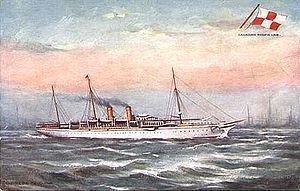Maiden voyage 15 July 1891 Launched 25 March 1890 Tonnage 5.357 million kg Builder Vickers-Armstrongs | Laid down 1890 Construction started 1890 Length 139 m Beam 16 m | |
 | ||
Name 1891-1913 RMS Empress of China Fate Scrapped in 1912, Yokohama | ||
RMS Empress of China was an ocean liner built in 1890-1891 by Naval Construction & Armament Co., Barrow, England for Canadian Pacific Steamships (CP). This ship—the first of three CP vessels to be named Empress of China—regularly traversed the trans-Pacific route between the west coast of Canada and the Far East until she struck an underwater reef and sank in Tokyo harbour in 1911.
Contents
Royal Mail Ship
In 1891, Canadian Pacific Railway (CPR) and the British government reached agreement on a contract for subsidized mail service between Britain and Hong Kong via Canada; and the route began to be serviced by three specially designed ocean liners. Each of these three vessels was given an Imperial name.
The RMS Empress of China and her two running mates, the RMS Empress of India and the RMS Empress of Japan, created a flexible foundation for the CPR trans-Pacific fleet which would ply this route for the next half century.
History
The Empress of China was built by Naval Construction & Armament Co. (now absorbed into Vickers Armstrongs) at Barrow, England. The keel was laid in 1890; and she was launched on 25 March 1891.
The 5,905-ton vessel had a length of 455.6 feet, and her beam was 51.2 feet. The graceful white-painted, clipper-bowed ship had two buff-coloured funnels with a band of black paint at the top, three lightweight schooner-type masts, and an average speed of 16-knots. This Empress and her two sister-ship Empresses were the first vessels in the Pacific to have twin propellers with reciprocating engines. The ship was designed to provide accommodation for 770 passengers (120 first class, 50 second class and 600 steerage).
The SS Empress of China left Liverpool on 15 July 1891 on her maiden voyage via Suez to Hong Kong and Vancouver. Thereafter, she regularly sailed the route between Canada and the east coast of Asia. In the early days of wireless telegraphy, the call sign established for the Empress of China was "MPG."
Much of what would have been construed as ordinary, even unremarkable during this period was an inextricable part of the ship's history. In the conventional course of trans-Pacific traffic, the ship was sometimes held in quarantine, as when it was discovered that a passenger from Hong Kong to Yokohama showed signs of smallpox, and the vessel was held in Yokohama port until the incubation period for the disease had passed. The cargo holds of the Empress would have been routinely examined in the normal course of harbor-master's business in Hong Kong, Yokohama or Vancouver.
Amongst the celebrities sailing on the Empress, was Archduke Franz Ferdinand of Austria. On 25 August 1893, the Archduke boarded the ocean liner at Yokohama for a voyage across the Pacific to Vancouver.
On 27 July 1911 the Empress encountered rough seas and thick fog 65 mile south of Tokyo harbor. She struck a submerged rock off the Nojima Saki Light while trying to round the southern tip of the Awa peninsula inbound for Yokohama. Submerged rocks extend about a mile from the coast in an area of the bay which is known for its dangerous currents. This accident occurred very close to where another ship foundered on the rocks in 1907. The Japanese cruisers Aso and Soya were dispatched to assist in removing mail, baggage, and passengers. The ship was abandoned with no loss of life. A year later, the Empress was re-floated; and in October 1912, she was towed into Yokohama where she was dismantled and scrapped.
CP Empresses of China
In 1921, Canadian Pacific added two German-built vessels to the Empress fleet; and initially, both were confusingly renamed Empress of China. A quick explanation will help distinguish these the quite different ships which each sailed with the same name.
